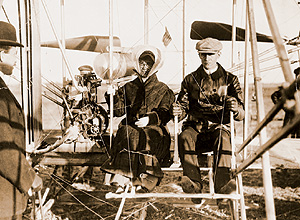


 |
Issue Contents :: Feature Stories :: Wright
On, Sister :: Page [ 1 2 3 4 ]
Katharine was just as blunt on other matters, as excerpts from her correspondence illustrate. "I am reading Sinclair Lewis' new book (Elmer Gantry) today," she wrote to a friend in 1927. "He had one sent to Harry. I told Harry I wouldn't spend $2.50 on it, and what's more, wouldn't let him spend any money for such trash as it is."
 |
|
| Wilbur and Katharine Wright seated in the Wright Model A Flyer with Orville Wright standing nearby. This was Katharine's first time flying. Her skirt is tied with a string. |
But her vexation with men stopped when it came to her brothers; for them, she would sacrifice anything. In 1896, prior to her junior year at Oberlin, Orville fell ill with typhoid fever, the disease that would kill Wilbur 19 years later. In what became a familiar pattern—and a test of her competing devotions to career and family—Katharine put her brother ahead of herself, foregoing fall classes to nurse him to health. In 1908, when Orville's plane crashed at a U.S. Army flying exhibition and he was nearly killed, Katharine took emergency leave from her teaching position and spent six weeks at his hospital bedside in Washington, D.C. Orville's passenger, Army Lt. Thomas Selfridge, had perished—the first to die in a flying accident. Katharine was the only sibling of the three with a steady income to pay their collective living expenses. "School can go and my salary, too," she wrote to Wilbur. "Little brother shall not be neglected as long as I am able to crawl around."
The Wright brothers were part of the highly competitive race to create a machine that could fly under its own power. What they lacked in money, they made up for in ingenuity—their airplane, by and large, was built of bits and pieces machined in their popular Dayton bicycle shop. They read widely in the sciences, and their inventions were legendary: a wind tunnel that measured the performance of various wing shapes to determine which produced the greatest lift; a wing warping method that controlled an aircraft's maneuvers in the air; and a system of carefully designed wings and a propeller that lifted a machine off the ground and kept it airborne.
In the race to be the first, the Wrights trounced such heavily financed competitors as the Smithsonian Institution's Samuel Langley, whose aircraft ripped apart in mid-air and plunged into the Potomac River in December 1903. Nine days later—December 17—it was the Wright brothers who made history with four flawless flights at Kitty Hawk. But the feat was largely ignored, even in their hometown press.
Katharine continued to teach while Orville and Wilbur returned home to work out the kinks in their airplane. There were many. In the cold heavy air of Kitty Hawk, and with the aid of an ocean headwind, the plane could fly, but not in the higher elevation of Ohio, with its lighter air and light winds.
Slowly, they resolved the problems. The world, meanwhile, forgot about the Wrights, believing still that powered flight was impossible. Katharine discovered as much upon inviting her students and fellow teachers to watch a flight one afternoon. No one showed up. "Scarcely anyone believed in [the airplane] until he actually saw it with his own eyes," Orville remarked.
Not until the Wrights began a series of flying exhibitions did the public take notice, pulling Katharine gradually into the world of aviation. She began handling her brothers' growing volume of business correspondence and paid the bills when household cash was short. Always poised and gregarious, she guided the men through a maze of fame that rippled, swelled, and then threatened to overwhelm.
An urgent letter from Wilbur to his father in 1907 hinted at what was to come. Wilbur needed an immediate American Express money order to pay for two new suits. "I cannot hobnob with the Emperor when I get to Berlin without some clothes," he wrote.